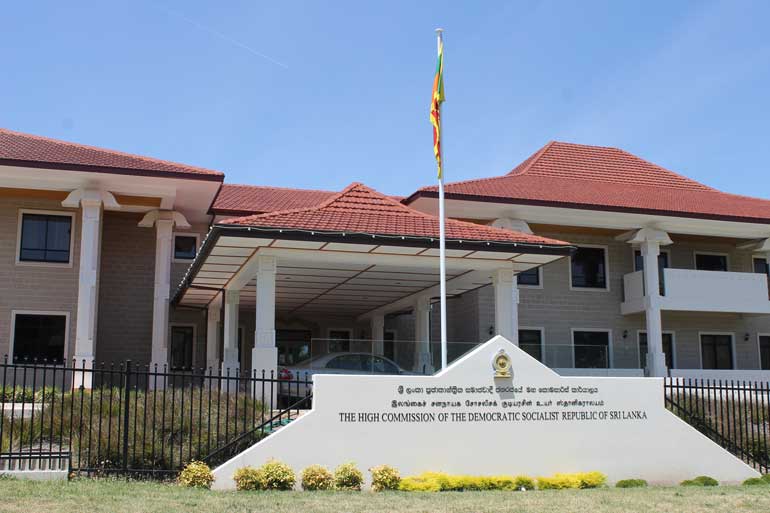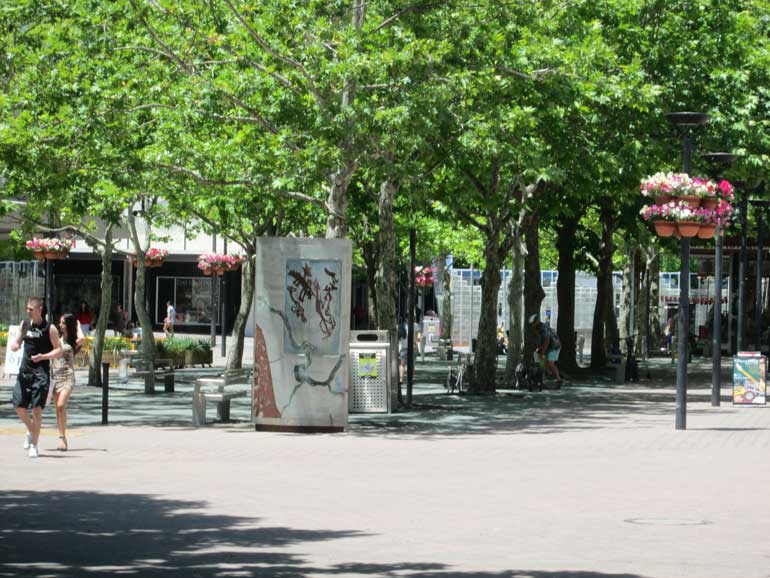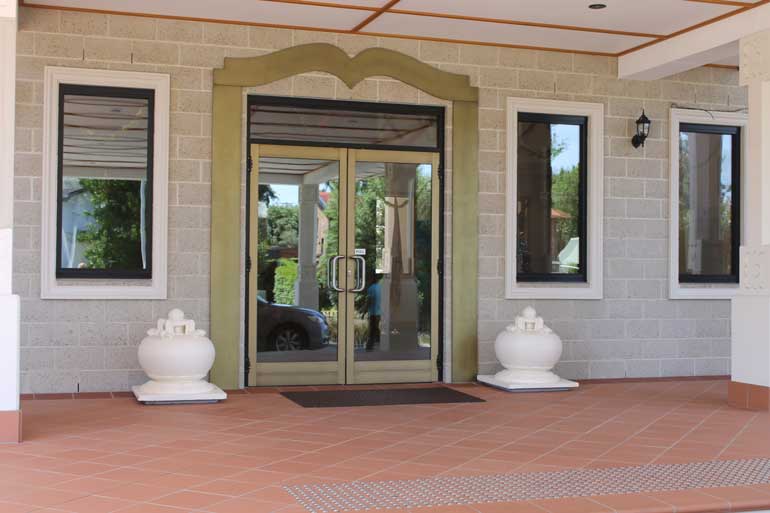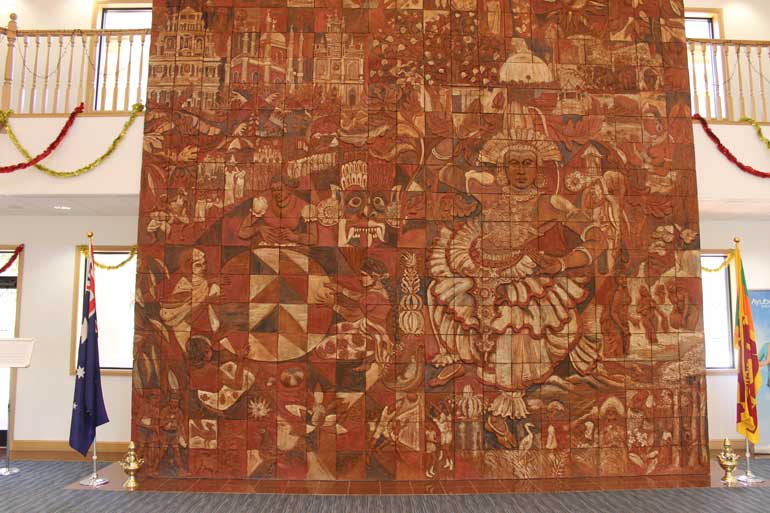Wednesday Feb 12, 2025
Wednesday Feb 12, 2025
Saturday, 19 December 2015 00:10 - - {{hitsCtrl.values.hits}}

Builing

City walkway

Entrance

Mural
By D. C. Ranatunga
It was Sunday morning. We were spending the weekend in Canberra having driven from Sydney on Saturday to say ‘hello’ to the High Commissioner Somasunderam Skandakumar whom I had known for many decades back in Sri Lanka. He has such a busy schedule we were lucky to catch him on a relatively free weekend though in between he had a few appointments including a lunch on Sunday. When I told him at dinner on Saturday I was keen to see the newly built High Commission office, he was more than happy to take us round on Sunday morning.
It was my second visit to a Sri Lankan embassy. The first was in the mid-1960s when I paid a courtesy call on Professor G. P. Malalasekera, the High Commissioner in London at the time. I was in UK on a Commonwealth Press Union Fellowship.
Canberra High Commission is an imposing building with a totally Sri Lankan touch. A moonstone at the steps, two ‘pun kalas’ on either side of the main door and a large terracotta mural greet the visitor. In a corner on the left of the spacious hall are flags of the different provinces of Sri Lanka. In fact, a visitor may start looking for the office! He will soon realise he had walked into a visitor-friendly place and will see the reception desk is on the right.
I knew the office was built during the tenure of the previous High Commissioner Admiral Thisara Samarasinghe. He had taken great care to ensure a fine mix of tradition and modernity had been achieved. “It’s a great job – something that we can be proud of,” Skandakumar said.
“Who was the architect,” was the obvious question. “A Sri Lankan, Jayantha Madawela,” he replied.
My mind lashed back to the late 1980s when I had visited Canberra and stayed with him. I had known him from his student days at Katubedda campus. He was in the first batch of the Architecture course. He has made Canberra his home.
Walking into the hall all eyes naturally go to the 19 feet tall, 20 feet long mural in the foyer. Flanked by the Sri Lankan and Australian flags on either side, it’s so attractive and conveys so much prompting any visitor to have a close look at the work of Professor Sarath Chandrajiva based on the conceptual drawing by Professor Albert Dharmasiri. Both are renowned artists attached to the academic staff of the University of Visual and Performing Arts in Colombo.
A framed note explaining the concept is kept by the side of the mural for anyone interested to read. The note states that the mural made of red earthenware terracotta contains 380 tiles “skilfully and painstakingly hand crafted and painted with earth colour slips”.
The note records that High Commissioner Admiral Samarasinghe’s chosen theme ‘Sri Lanka’s countryside’ is well and truly realised. “He ensured that the artwork, with its many facets, intertwined the rich cultural and religious heritage of Sri Lanka, its beauty, wild life, economy, lifestyle and national symbols,” the note says.
After explaining the elements in the mural in detail, the note ends thus: “The mural is more than an enthralling work of art. It serves as a symbol of hope for a harmonious future in spite of struggles past. The four women playing the ‘rabana’ prominently capture a multi ethnic celebration of Sinhalese, Tamils, Muslims and Burghers and take the viewer further to its depiction of their respective places of worship. This unique sculpture will no doubt evoke the admiration and sentiment of many.” It certainly does.
This handcrafted mural painted with earth colour displays is possibly the only such creation in a Sri Lankan mission abroad.
Walking across to the adjoining meeting hall there were posters depicting Sri Lanka’s natural beauty. The conference hall also gives a Sri Lankan touch. More paintings are laid on a side awaiting a suitable site to be hung.
The High Commission premises, quite large in extent and there is ample vacant space for future office or for housing for the staff.
Being a Sunday, Canberra city was virtually deserted. Tourists were seen walking about getting a glimpse of the place. It was soothing to walk through the walkways amidst trees and flower pots placed on posts adding lot of colour.
A fruitful weekend it was.
Discover Kapruka, the leading online shopping platform in Sri Lanka, where you can conveniently send Gifts and Flowers to your loved ones for any event including Valentine ’s Day. Explore a wide range of popular Shopping Categories on Kapruka, including Toys, Groceries, Electronics, Birthday Cakes, Fruits, Chocolates, Flower Bouquets, Clothing, Watches, Lingerie, Gift Sets and Jewellery. Also if you’re interested in selling with Kapruka, Partner Central by Kapruka is the best solution to start with. Moreover, through Kapruka Global Shop, you can also enjoy the convenience of purchasing products from renowned platforms like Amazon and eBay and have them delivered to Sri Lanka.
Discover Kapruka, the leading online shopping platform in Sri Lanka, where you can conveniently send Gifts and Flowers to your loved ones for any event including Valentine ’s Day. Explore a wide range of popular Shopping Categories on Kapruka, including Toys, Groceries, Electronics, Birthday Cakes, Fruits, Chocolates, Flower Bouquets, Clothing, Watches, Lingerie, Gift Sets and Jewellery. Also if you’re interested in selling with Kapruka, Partner Central by Kapruka is the best solution to start with. Moreover, through Kapruka Global Shop, you can also enjoy the convenience of purchasing products from renowned platforms like Amazon and eBay and have them delivered to Sri Lanka.